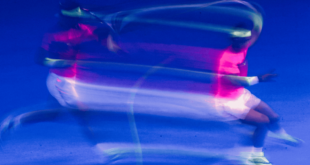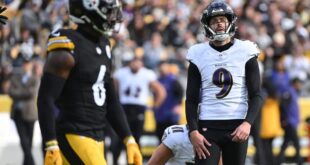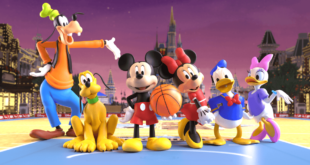MONTREAL — When Austin Kaiser arrives at a PGA Tour stop, he first does his homework: He walks every inch of the golf course for his player, Xander Schauffele. Maybe he talks to a few other caddies along the way, chatting with a buddy or two as he scribbles notes and maps greens in his yardage book. But if Kaiser finds something — a particular yardage that might be useful, a piece of relevant information about the 18-hole conundrum ahead — he resists the urge to share it. Kaiser, now a two-time major-winning caddie, has learned to keep his lips sealed.
“Xander’s like, don’t help anybody!’” Kaiser says, “It’s a competitive edge. If we’re playing in a major and I have information that can help them possibly beat us, why would I do that?”
Kaiser’s thought process is self-explanatory and common among top-tier caddies. But that mindset is lost for one week a year.
At the Presidents Cup this week (and the Ryder Cup in other years), 24 individual golfers suddenly get to be part of two 12-man teams. And that means their caddies do, too.
No one gets paid. No one is earning OWGR points. For one week, 12 players are trying only to beat the opposing team in front of them, and to do so, they must throw themselves into one unit of operation. It’s difficult because golfers have been programmed to be individual athletes since their junior days. But if they don’t come together, it seldom ends well — as history has shown.
The 12 caddies on these teams are sneakily important to that week-long pursuit of unity. At most team events, the caddies even have their own “caddie captain” to act as the ringleader for the group. It’s typically the captain’s current caddie, but amid concerns about the 76-year-old Fluff Cowan’s recovery from hip replacement surgery and ability to use group text, Kaiser has taken on an increased role.

Caddies and players for the U.S. team will be together this week, on and off the course. (Chris Condon / PGA Tour via Getty Images)
During a team event, the 12 loopers don’t just walk the golf course alongside each other, they walk it together, sharing observations and exchanging opinions on how to play each hole. When they get the pin locations for competition days, they meet at the team hotel and work through the sheet, green by green, discussing the best spots for their players to “miss.” Then alternate shot pairings are released, and the partnered caddies join forces and collaborate with team statisticians to figure out where to place each player on each hole.
“There are a few caddies every week at a tournament who I may talk to about the golf course, but now we have 12 of the best caddies in the world giving their input on how to play it,” says Joe Greiner, Max Homa’s longtime caddie.
“For the most part, it’s you and your guy. That’s it,” says Paul Tesori, Tom Kim’s caddie and the former caddie for Vijay Singh and Webb Simpson. “But as soon as you get named to one of those teams, there is a completely different atmosphere.”
The team operation has always expanded beyond just the players. But for many years, the significance of caddies at the Ryder Cup and the Presidents Cup was overlooked — or reduced to a sideshow, like Joe LaCava’s Marco Simone dust-up with Rory McIlroy or Tesori’s ill-fated decision to wear a “Tiger Who?”-inscribed hat to Singh’s 2000 Presidents Cup singles match.

GO DEEPER
Presidents Cup analysis: 10 notes to know on U.S. vs. International
Now the tides are starting to change.
This spring, veteran caddie and current NBC on-course commentator John Wood got a call from then PGA of America CEO, Seth Waugh. On the phone, Waugh described a new role being created for the U.S. Ryder Cup organization: Team Manager. “I swear to you, my first thought was, ‘Oh man, how cool is this? They think enough of me to ask for a few names I would recommend for the job,’” Wood says.
A few phone calls later, Wood got the news — the job was his. He was baffled and honored all at once. “There is nothing, and I mean nothing, in my professional career, that I have been more passionate about than the Ryder Cup,” Wood said.
After a 20-plus year career of caddying for players like Mark Calcavecchia and Hunter Mahan, Wood had now been tapped for a vital role with one of the biggest events in the sport. Starting with the 2025 Ryder Cup at Bethpage Black, Wood will work directly with the American team, including captain Keegan Bradley, his vice captains and players, on all “strategic and operational matters” related to the competition, according to the PGA of America.
It’s a huge role. And it’s a huge indicator of how valuable figures like Wood are to the American team golf pipeline.
At Royal Montreal, the players and caddies share a locker room and a team room. They’re together at the golf course, and they’re together when they go back to their accommodations to decompress. They do the whole week as one team. At the 2023 Ryder Cup at Marco Simone, there were separate rooms for caddies and players back at the team hotel. Greiner says he was 100 feet away from Homa most nights in Rome, but the two were texting each other from their respective spaces.
“One of the nice things about the Presidents Cup is that they have a USA room at the hotel that’s for players and caddies, and it’s where we eat dinner, play ping pong, and hang out,” Greiner says. “Sometimes in this game when you get everyone away from the golf course, everyone loosens up and you see everyone’s personality more when we’re all in one room. (Rome) was very strange, if I’m being honest.”

Joe Greiner is in his third team event as Max Homa’s caddie. (Minas Panagiotakis / Getty Images)
So far, Wood’s new placement as team manager has shown positive signs for caddie integration: It’s increasingly looking like the setup at Bethpage will take after this week’s Presidents Cup configuration.
“We can’t make requests, we’re caddies. So we have Wood to do that for us,” Kaiser says. “He already talked to Keegan, and Keegan’s like, we’re doing one team room. We’re going to make it the most unified room ever.”
The first indication of the caddie treatment at team events comes when each looper receives an email in their inbox ahead of the competition. It asks for their clothing and shoe size. “Caddies don’t get those questions — ever,” Tesori says.
Then their travel is taken care of and their hotel rooms are covered. At regular PGA Tour events, caddies are responsible for all of their own logistics and expenses. The accommodation provided at a team event can feel like stepping into an entirely new world — a weight lifted off their shoulders. Instead of leaving the course alone at the end of a brutally long tournament day, the caddies at this week’s Presidents Cup will go back to a shared space of like-minded golf fanatics, ready to trade stories and unpack the day’s drama. It’s not unheard of for a caddie, fearful his player has heard the same message from him so many times it lost its impact, to ask a peer to relay a bit of advice to the player the next day.
Veteran caddies often take pride in sharing memories from previous cups and pointing rookies in the right direction. It’s an excellent opportunity to learn, too. Whether you realize it or not, being a caddie during a team event means unlimited access to some of the smartest minds in the game. Several caddies point to Wood and Ted Scott as influential voices that stand out.

GO DEEPER
Who is going to play their best at this Presidents Cup? It’s all about the fit
Of course, the transient nature of the caddie business means the best often find themself with one team one year and with another the next.
Nearly 20 years after Singh and Woods’ singles match, Woods captained the 2019 Presidents Cup. Tesori was caddying for the Americans this time, for Webb Simpson. When he showed up for U.S. team pictures, Woods was wearing a hat with “Paul Who?” and “2 and 1” scribbled on the cap.
20 years later… 😂
Captain @TigerWoods finally gets his revenge on former #IntlTeam turned #USTeam caddie, @PaulTesori pic.twitter.com/3DALDHMNn2
— Presidents Cup (@PresidentsCup) December 10, 2019
Woods always recognized the benefits of caddie input to the team. As a captain, he’d frequently approach the loopers — out of the players’ earshot — and ask all sorts of questions: How’s this player looking? Why don’t these two players want to play together?
Woods knew that the asset of 12 professional caddies working together was not one to cast aside. As past events have demonstrated, caddies are just as invested in the outcome of these team competitions as the players. And the reason behind that trend is as relatable as it gets.
“We don’t like losing either,” Kaiser says. “We’re basically golfers who didn’t make it. We live vicariously through our players.”
(Top photo of Jonathan Jakovac, left, and John Ellis: Ben Jared / PGA Tour via Getty Images)
 meganwoolsey Home
meganwoolsey Home



